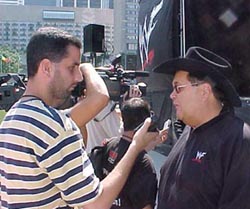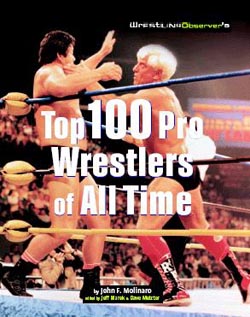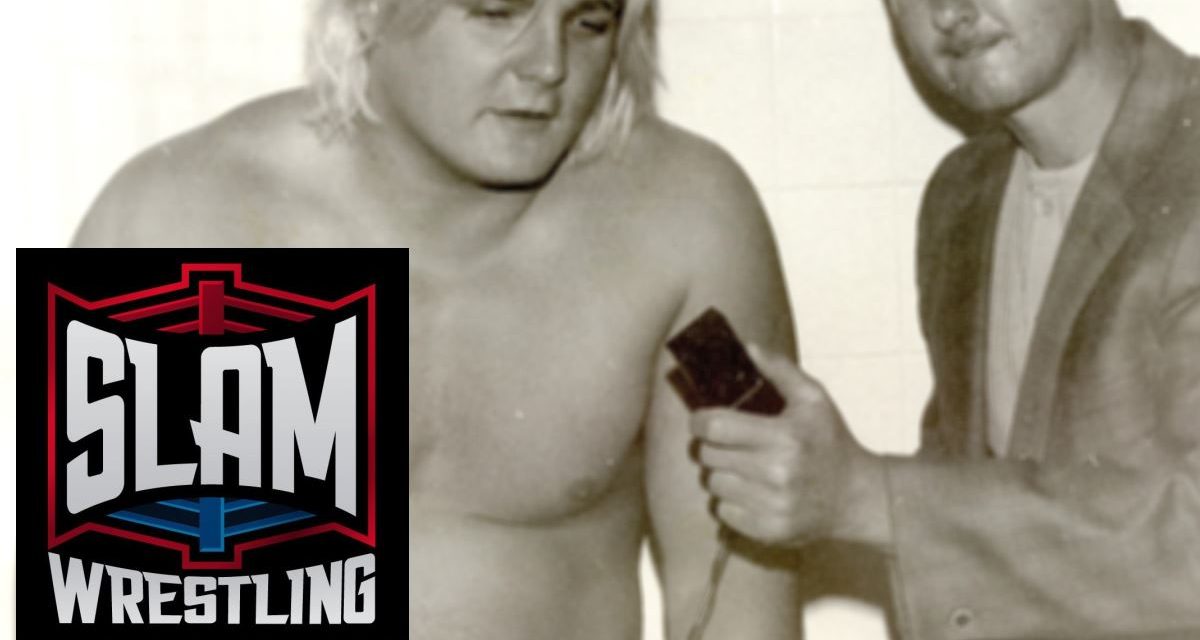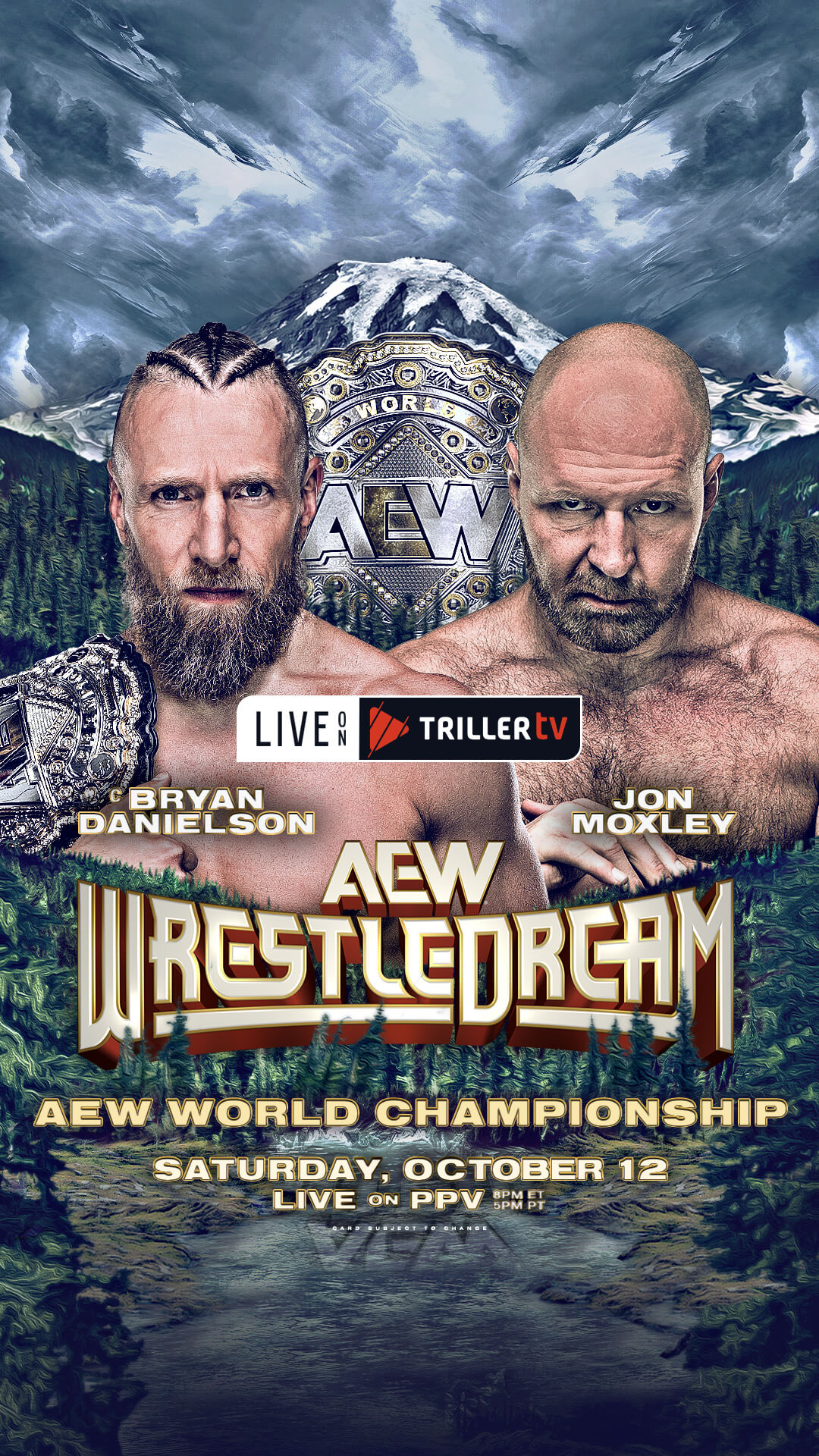SLAM! Wrestling is 10 years old, and it’s a time for reflection. Myself, I’ve been writing for SLAM! since 1998, but one of the early heralded writers was a young intern named John Molinaro. John’s writing and loyalty helped him gain a prominent position at SLAM! Wrestling. Though he hasn’t written for the site in a few years, I caught up with him to go over the old times.
After all, he’d seen a lot. John was there when the WWE granted SLAM! Wrestling press access to events. He was also there when it was cut off. He’d interviewed big stars and small, shone the spotlight on the Mexican and Japanese stars, and more than pushed a few buttons too.
I thought it would be a good idea to chat with John to talk about the past, talk about what could have been and talk about the future. John is truly missed on the site, but don’t feel sorry for him, he is doing quite well for himself.
Chris Schramm: Do you remember how you got involved in SLAM! Wrestling? I know you were a big follower of International wrestling.
John Molinaro: I just finished journalism school and was looking somewhere to serve my internship. I knew Greg (Oliver) back when he published his newsletter the Canadian Wrestling Report, so I contacted him about interning at CANOE. Once I was there, I began writing stuff for SLAM! Wrestling and was hired on full-time once my internship was done.

John Molinaro, left, interviews Jim Ross at a press conference announcing WrestleMania 18 coming to Toronto.
Greg was really the key. When he was publishing the Canadian Wrestling Report, I corresponded with him frequently and talked to him on the phone. Then we lost track of each other before I saw that he was running SLAM! Wrestling. He remembered me and the rest fell into place from there.
Chris: SLAM! Wrestling really stood out as a respectable news source. How do you think SLAM! Wrestling’s style helped gain respect within the industry?
John: I think SLAM! Wrestling’s style was the main reason why it gained so much respect because it was so unique. When you look at the explosion of wrestling internet sites that popped up in the late 1990s, most of them were bulletin-board type websites with lots of rumors and speculation. SLAM! Wrestling really distinguished itself with its in-depth coverage of news stories, long-form features and actual news articles. I really think of SLAM! Wrestling as an online newspaper for wrestling fan, and I think that’s why it has stood as one of the best sites out there.
SLAM! Wrestling is the only really high-profile wrestling website that provides its readers with this type of in-depth, analytical coverage and that’s why it has gained so much respect within the industry. My hat really goes off to [founders] Greg [Oliver] and [John] Powell for this because when they launched the site, it would have been so easy to go the other way (run a bulletin board site). They had the right vision for the site and that has made all the difference in the world.
Chris: I think maybe that explains the longevity of the site. We also archive every article. So if you want to see what we wrote in 1998, you can see it. It’s the largest online archive for wrestling, I’d assume. SLAM! Wrestling had a lot of respect within the industry, as we said. That respect really saw some big names come to SLAM! Wrestling. Roddy Piper, Dave Meltzer, Lou Thesz, to name a few, came to promote books. You met a lot of them. What was it like meeting these people and helping with the live chats SLAM! Wrestling hosted with them?
John: The live chats were great because I often found the wrestlers were much more honest and open with their views than when you interviewed them one on one.
The chats also gave our readers a chance to interact with the stars.
I really enjoyed doing the chats because I got to talk about issues in wrestling with people I really respected. Talking to Lou Thesz about his days as NWA World Champion, you can’t beat that. I grew up watching Mid-Atlantic wrestling so speaking to Roddy Piper about the old Crockett Promotion and his cage match against Greg Valentine at Starrcade ’83 was a thrill.
Chris: It is one of the perks of the job.
Carl DeMarco, WWE’s Canada President, and you had some interesting conversations from what I hear. What do you remember about your talks with him?
John: That’s a question for Greg because I wrote several negative articles regarding the WWF and Carl always called Greg to complain about me.
Chris: Your book, Top 100 Pro Wrestlers of All Time, is amazing. It is in my top five wrestling books, and I recommend it to anyone who likes wrestling. Tell me about writing the book and how working with SLAM! Wrestling helped the book come about.

John: Well, I never would have received the chance to write Top 100 if it wasn’t for SLAM! Wrestling. I had been working at SLAM! Wrestling for just over two years when I was approached about writing the Top 100. The publishers were familiar with my work at SLAM! Wrestling and thought I would be a good choice to write the book. I met with them and they told me how much they respected my work and they offered me the chance to write the book. They were also considering Bryan Alvarez, but in the end they went with me.
Writing the book was a great experience, but the biggest mistake I made was telling friends, colleagues and family about it. During the entire writing process, friends would continually be hounding me about who was in the top 10 or try to persuade me to include one of their favorites. My brother was the worst one, too. I remember telling him Greg Valentine didn’t make the list, and he nearly had a fit. Then, of course, the book came out, and people were giving me hell for all kinds of reasons — why was Hogan rated so low, where was Honky Tonk Man, why were there so many Japanese and Mexicans.
Chris: I know our store has the book for a great price. I recommend it for the bios and photos. I know when reading it, was shocked at some of the ranking for the International stars. El Santo is compared to Muhammad Ali in Mexico. No U.S. wrestler comes close to his popularity within his own country. Also, Rikidozan was a phenom in the late 1950s, bringing ratings higher than the Super Bowl gets in the U.S.
SLAM! Wrestling was a site that was not just quick rumors and blurbs. It based around research, interviews and a writing style that was like no other site out there. What do you remember about some of those articles that stood out?
John: Yeah, I think that’s what made SLAM! Wrestling stand out and that is the site’s greatest strength. John and Greg were very big on in-depth articles and they really impressed that upon me when I first started with SLAM! Wrestling.
I remember in writing the story of the 25th anniversary of the Ric Flair plane crash; I must have interviewed about 20 different people: from David Crockett and Tim Woods (who were on the plane), to Mike Mooneyham and Dave Meltzer. I even tracked down the reporter who wrote the news story about the crash in a local Charlotte newspaper when it happened.
I did a series of stories on Johnny Valentine, both before and after his death, that were based on very emotional conversations I had with his wife. Those stories were real gut-wrenchers to write.
The two stories I am most proud of are the one on the legend of El Santo and the one of the fifth anniversary of Art Barr’s death. Those took me weeks to write because I interviewed lots of people and did a ton of research. SLAM! Wrestling readers, in general, had very little knowledge of Mexican wrestling, so I think these articles really served as an introduction to lucha libre and Mexican wrestling culture. What was great was that I had so many people e-mail to ask me where they could watch Mexican wrestling on TV or buy some VHS tapes because they wanted to check it out for themselves.
Chris: It is all about research for me. Even a recent article about Kurt Angle’s in-ring TNA debut featured interviews from five people that work for TNA. Every article at SLAM! Wrestling really takes that extra step.
What did you learn from John and Greg? What do you think you taught them? Was it a work relationship or were you social outside the office?
John: Oh geez, I learned so much from Greg and John. You have to remember I was fresh out of journalism school when I first came to SLAM! Wrestling so I absorbed as much as I could from Greg and John.
I think the main lesson I learned from John was how to conduct yourself and be professional in this business. I’ve come into contact with hundreds of reporters and people in the media in my time, but none have exhibited more professionalism than John. John really knows how to deal with people in the correct manner.
Greg was very much like a mentor to me. He was always challenging me to look at a story from a different angle and to always dig deeper than the surface. The other thing I learned from Greg is that sometimes less is more. There were a lot of times he had to reign my stories in because they were a bit over the top. I’m much more mature in my writing and reporting style now, and that’s due to Greg’s influence.
Both Greg and John had a tremendous influence on me and my maturation as a journalist. I owe them so much.
I don’t think there’s anything I taught Greg and John during my time at SLAM! Wrestling. They learned a little bit more about Japanese and Mexican wrestling culture because I was always writing about it, but I think that’s about it.
Our relationship extended well beyond the office. We were and still are close friends. I got to know John’s wife and young son during my time at SLAM! Wrestling because I was always at his house for pay per views. I still go to Greg for advice whenever I need it.
Chris: Greg is very understanding. He is honest and tries to make you a better writer. He does the little things that makes your next article better.
Wrestlemania 18 was going to be huge for SLAM! Wrestling. Wrestlemania was in SLAM! Wrestling’s hometown of Toronto. Before the event, WWE cut off ties with all Internet sites. Did that really hurt SLAM! Wrestling as much as it appeared? What changed because of it, besides the obvious?
John: Actually, the cut off happened just days after WrestleMania 18. I remember being pissed about this because they waited until after Wrestlemania was over, once they got a lot of mileage out of the media coverage, to announce it was cutting off all contact.
The cut off didn’t really hurt us and things changed back to the way they were before Jim Ross extended us the olive branch and spoke to us.
Chris: Jim Ross was (and is) a big fan of SLAM! Wrestling. And he really helped with the communication between SLAM! Wrestling and the WWE. How was it working with Ross? And what do you remember him saying about SLAM! Wrestling and the WWE following the cut off.
John: Jim was great. I have a lot of respect for him because he really went to bat for us and others in terms of challenging the WWF media policy at a time when it was a very sensitive issue within the company. I honestly counted him as one of the few friends I made covering the business; he was one of the people I thanked in the dedication portion of my book.
Jim really respected what we did and I think that was the key to us forming a relationship with him. I can recall a two-hour phone conversation we had just talking about our love of wrestling and you could tell that Jim would just die for this business.
That article I wrote slamming the WWF media policy was what led to the relationship because after I spoke with him and smoothed things over a bit, he gave me his private office number, his cell and his pager and told me to give him a call anytime we needed to speak to him to get a comment for a story we were working on. We ended up making good use of this access and wrote dozens of exclusive stories with a comment from Jim Ross.
I think Jim understood, unlike the McMahons, that it didn’t make sense to have an antagonistic relationship with the wrestling media and he tried to bridge that gap as best he could. Nothing was really said after the cut off — he called me up after the cut off was announced publicly and explained it was the McMahons’ decision and that there wasn’t anything he could to about it. He was put in a difficult position because he still wanted to maintain that relationship but couldn’t.
Chris: In the last few years, WWE has been great to us, again, and we have had some good access lately. We hope that continues. Is there any memory that stands out above the rest, and not just you, but for the site as a whole?
John: Oh geez, too many memories to name.
I suppose the article I wrote questioning the WWE’s media policy stands out because that created such a shit storm. Covering Wrestlemania 18 in Toronto, I think, was a big deal for SLAM! Wrestling because it made us the website of record for that event.
Personally, my favorite memories are going to Powell’s house on Sundays and watching the pay per views with the entire SLAM! Wrestling crew.
Interviewing Vampiro and then writing my first article for SLAM! Wrestling was also a special memory.
Chris: Ten years has passed since SLAM! Wrestling started. Why is it still around?
John: Two reasons, Chris. One, because SLAM! Wrestling is the only website that does the kind of work it does. The in-depth news analysis, the features, the insightful news reporting, you’re just not going to find that anywhere else on the web. I think this approach has made SLAM! Wrestling stand out from the rest and allowed it survive and thrive, because nobody else is doing it.
I think a perfect example of this is the recent controversy with Cpl. Kirchner. Every other site was quick to write his obit and relied on a statement from the WWE when reporting on his supposed death, but Greg actually investigated and found it was a hoax. Not only that, he spoke exclusively with him about his life. No other website would have taken the time to do the leg work that Greg did on that story.
I think the other major factor as to why it’s still around is Greg. He has a passion for this business and for wrestling journalism as a whole. He’s been reporting on it since he was a teenager with the Wrestling Report and I think it’s his passion that drives the site.
I don’t want to downplay the contributions of others such as Powell or Bob Kapur or myself, because I think we’ve all played a key role in helping SLAM! Wrestling become what is today. That said, Greg really believes in the site, it’s his passion, and without him, it would have died long ago.
Chris: Agreed. Greg’s love for his job really helps, and I am not saying that because I work for him. If you could change one thing about SLAM! Wrestling, what would it be?
John: If I could make any changes, it would be to the wrestling business as a whole, but that’s another story. Regarding SLAM! Wrestling, I would like to see them do more house show reports. I think there’s a big appetite amongst readers to know what’s going on at the house shows away from the TV cameras.
Chris: We aren’t perfect. It is 10 years from now, are we are chatting about SLAM! Wrestling’s 20th Anniversary?
John: As long as Greg is still around, I think we will be!
Chris: Greg is really why it is what it is. How would you summarize your experience with CANOE and SLAM! Wrestling?
John: Just that I was very proud to be a member of SLAM! Wrestling for three years and I look back at my time there with a great deal of fondness. It was a fun time but it was also a great learning experience and I think my tenure there really helped me become the reporter I am today at CBC Sports Online.
RELATED LINK


